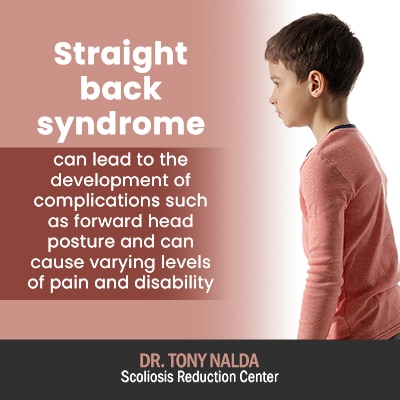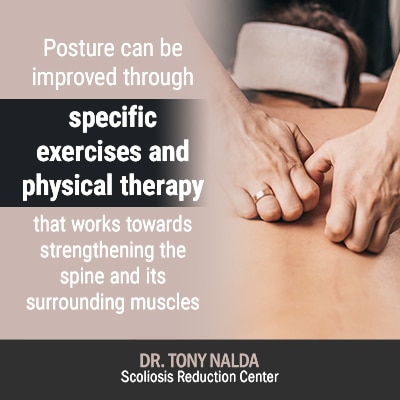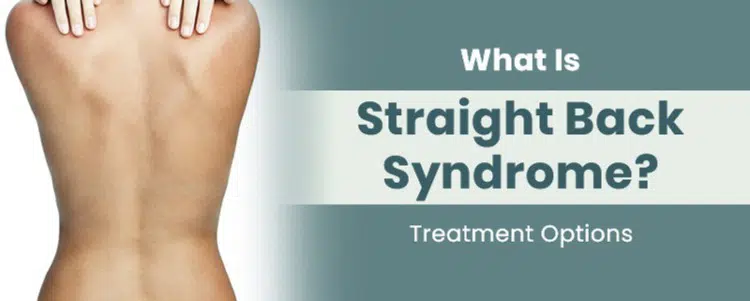The spine’s natural curvatures are important for preserving its overall health and function; they help make the spine stronger, more flexible, and better able to support the weight of the neck, arms, and trunk. When the spine becomes unnaturally straight, its biomechanics are disrupted and can cause a number of symptoms. Keep reading to learn more about straight back syndrome.
Also known as straight spine syndrome or flatback syndrome, straight back syndrome involves the loss of one or more of the spine’s natural curves. When this happens, the spine can become unnaturally straight, giving the body a pitched-forward appearance, and needs to be treated proactively.
To understand the nature of spinal anatomy and function, let’s talk about the spine’s natural curvature types.
The Spine’s Healthy Curves
The spine has three main sections: cervical (neck), thoracic (middle/upper back), and lumbar (lower back).
Each of the spine’s main sections has a characteristic curvature type known as kyphosis and lordosis.
The spine’s kyphotic curve is in the thoracic spine, while the spine’s lordotic curves are the cervical and lumbar sections; these natural and healthy curves help distribute mechanical stress throughout the spine both during activity and when at rest.
While a healthy spine has a natural curvature-degree range of kyphosis and lordosis, problems can occur, such as the development of related conditions like straight back syndrome when a person’s range falls beyond that healthy range.
What is Straight Back Syndrome?
There are a number of spinal conditions that involve a loss of its healthy and natural curves, disrupting the spine’s natural strength and function.
When the spine loses its kyphosis, lordosis, or both, it can become unnaturally straight and disrupt the spine’s biomechanics; this is known as straight back syndrome.
Straight back syndrome gives the body a pitched-forward appearance, making it difficult to stand up straight and to stand for long periods of time.
While every case is different, in addition to the stooping back, straight spine syndrome can cause the following symptoms:
- Painful back muscles
- Mobility restrictions
- Fatigue
- A feeling of falling forward
- A pronounced stoop at the end of the day
In some cases of the flatback syndrome, patients will need a cane or walker to assist them with walking due to their pitched-forward posture not evenly distributing the body’s weight over the pelvis and legs.
Being off-center can make simple tasks like walking difficult, and varying fatigue levels can develop as the body is in a constant struggle to maintain balance.
The body tends to compensate for its flat back by shifting the head and neck forward, and this forward head posture can lead to strained and tight neck and upper back muscles and pain in the shoulders.
Forward head posture involves a shifting forward of the head, and even as little as an inch forward is said to increase the weight of the head by 10 pounds. This exposes the neck muscles and shoulders to uneven pressure and strain. As the neck’s surrounding muscles become imbalanced, the cervical spine loses valuable support and stabilization.
Fortunately, chiropractic treatment for forward head posture can be effectively corrective. Subtle and precise vertebral adjustments can work towards reversing joint fixations and re-activating the muscles that support the head.

Straight back syndrome can lead to the development of complications such as forward head posture and can cause varying levels of pain and disability.
When people are diagnosed with straight back syndrome, they often want to know what caused the condition to develop, and as is the case with most spinal conditions, there are multiple causes.
Causes of Straight Back Syndrome
Straight back syndrome can have a variety of causes. Cases with congenital causes are infants born with the condition due to spinal bone malformations that occur in utero.
The presence of other spinal conditions like ankylosing spondylitis (inflammatory arthritis) can cause straight spine syndrome, as can compression fractures of the vertebrae (bones of the spine) caused by osteoporosis.
Degenerative disc disease that can occur in adults as they age and face natural spinal degeneration can also lead to flatback syndrome by affecting the spine’s intervertebral discs, as they provide the spine with structure.
In addition, surgical treatment such as a laminectomy or spinal fusion used to treat scoliosis can cause flatback syndrome, particularly with older patients.
So now that we know what causes the syndrome, what’s involved in the diagnostic process?
Diagnosing Straight Back Syndrome
When a patient comes to see me with indicators for straight back syndrome, the diagnostic process will start with taking the patient’s medical history, including any relevant spinal conditions or back surgeries.
Then I would conduct a comprehensive physical examination that would include a musculoskeletal and neurologic component.
I would also assess how the patient walks; I can tell a lot about a patient’s spine by the way they walk. It’s very common for a person’s gait to change with the development of various spinal conditions due to the body’s tendency to try and compensate for a loss of spinal curvature.
Next, I would take an X-ray of the entire spine to check for sagittal alignment or sagittal imbalance, and from the results, I would know what I need to assess and diagnose straight back syndrome.
So after a diagnosis of straight back syndrome, what can a person do to treat the condition proactively?
How Do You Fix Straight Back Syndrome?
Here at the Scoliosis Reduction Center®, I have experience treating various spinal conditions, including straight back syndrome.
My patients benefit from a conservative chiropractic-centered treatment approach as I feel this is the best way to preserve the spine’s overall strength and function while impacting the condition on a structural level, without the need for invasive surgery.
While spinal surgeons have their patients’ best interests at heart, spinal surgery can be costly, invasive, and carries serious risks and potential side effects.
While no treatment results are ever guaranteed, I’m able to fully customize effective treatment plans by combining different treatment disciplines: condition-specific chiropractic care, in-office therapy, custom-prescribed home exercises, and corrective bracing.
Condition-specific chiropractic care can work towards impacting the condition on a structural level by adjusting the most straightened spinal vertebrae back into a more natural alignment with the rest of the spine.

Posture can be improved through specific exercises and physical therapy that works towards strengthening the spine and its surrounding muscles.
Condition-specific exercises can help reverse the pattern of muscle imbalances that cause flatback in the lower back, including hamstring and abdominal stretches.
Common exercises used to strengthen the core, buttocks, neck, back, and shoulders can include:
- Side-lying leg raises
- Planking
- Chest stretches
- Back extensions
- Chin-ups
Hamstring stretches are particularly effective at restoring proper alignment of the lumbar spine. Physical therapy can include additional exercises, stretches, and other forms of treatment, including corrective bracing to provide optimal spinal support and stabilization.
Conclusion
The spine is an important part of human anatomy. It gives the body structure, allows us to practice good posture and stand upright, facilitates flexible movement, carries the body’s weight, and acts as its shock absorber.
The spine’s overall health and function are dependent upon its ability to maintain its natural and healthy spinal curves; this is important because it’s the spine’s natural curves (lordosis and kyphosis) that give it added strength, flexibility and facilitates its ability to absorb/distribute stress.
If the spine loses one or more of its healthy curves, as it does with straight back syndrome, the spine’s biomechanics are disrupted.
Straight back syndrome causes an unnaturally straight spine that gives the body a pitched-forward posture, making it difficult to stand upright, stand for long periods of time, and walk without a cane or walker.
Also known as straight spine syndrome and flatback syndrome, straight back syndrome can cause muscle imbalances that cause discomfort and lead to an improperly supported spine.
Causes for straight back syndrome can be congenital and often accompanied by other spinal conditions such as ankylosing spondylitis or osteoporosis, degenerative disc disease, and/or surgical procedures such as laminectomies or spinal fusion.
Treatment for straight back syndrome can include chiropractic care, physical therapy, custom-prescribed home exercises, and corrective bracing.
Exercises can be important for strengthening the spine and its surrounding muscles for optimal spinal support and stabilization.
Here at the Scoliosis Reduction Center®, I customize each and every treatment plan to address important patient and condition characteristics and work towards restoring as much of the spine’s healthy curves as possible.





